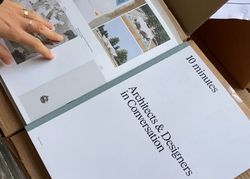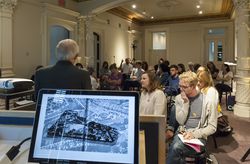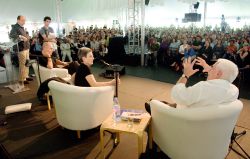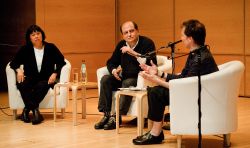archives
Level of archival description:
Fonds
Hazen Sise fonds
AP112
Synopsis:
The Hazen Sise fonds contains negatives, drawings, and other documents dating from 1933 to 1959. The negatives, taken in the early 1930s, mostly depict participants of the conferences CIAM IV and CIRPAC, including Le Corbusier, László Moholy-Nagy, Alvar Aalto and Fernand Léger. The drawings document the design of Beaver Lake Pavilion, built for the City of Montréal between 1955 and 1959 as part of the redevelopment of Mount Royal Park. Le fonds Hazen Sise est composé de négatifs, dessins, et autres documents datés entre 1933 et 1959. Les négatifs, pris au début des années 30s, présentent des participants des congres IVe CIAM et CIRPAC, incluant Le Corbusier, László Moholy-Nagy, Alvar Aalto et Fernand Léger. Les dessins documentent la conception du pavillon du Lac aux Castors, construit pour la Ville de Montréal entre 1955 et 1959 dans le cadre du réaménagement du Parc du Mont-Royal.
1933-1959
Hazen Sise fonds
Actions:
AP112
Synopsis:
The Hazen Sise fonds contains negatives, drawings, and other documents dating from 1933 to 1959. The negatives, taken in the early 1930s, mostly depict participants of the conferences CIAM IV and CIRPAC, including Le Corbusier, László Moholy-Nagy, Alvar Aalto and Fernand Léger. The drawings document the design of Beaver Lake Pavilion, built for the City of Montréal between 1955 and 1959 as part of the redevelopment of Mount Royal Park. Le fonds Hazen Sise est composé de négatifs, dessins, et autres documents datés entre 1933 et 1959. Les négatifs, pris au début des années 30s, présentent des participants des congres IVe CIAM et CIRPAC, incluant Le Corbusier, László Moholy-Nagy, Alvar Aalto et Fernand Léger. Les dessins documentent la conception du pavillon du Lac aux Castors, construit pour la Ville de Montréal entre 1955 et 1959 dans le cadre du réaménagement du Parc du Mont-Royal.
archives
Level of archival description:
Fonds
1933-1959
research
Visiting Scholars 1998–1999
Theme: The Baroque Phenomenon beyond Rome Annalisa Avon, Independent researcher, Fiume Veneto, Italy Topic: Baroque in France Before Bernini’s Arrival Dirk De Meyer, Universiteit Gent, Belgium Topic: Johann Santini Aichel (1677-1723) Rochelle Ziskin, Department of Art and Art History, University of Missouri-Kansas City, United States Topic: Lexicons of Feminity and(...)
September 1998 to August 1999
Visiting Scholars 1998–1999
Actions:
Description:
Theme: The Baroque Phenomenon beyond Rome Annalisa Avon, Independent researcher, Fiume Veneto, Italy Topic: Baroque in France Before Bernini’s Arrival Dirk De Meyer, Universiteit Gent, Belgium Topic: Johann Santini Aichel (1677-1723) Rochelle Ziskin, Department of Art and Art History, University of Missouri-Kansas City, United States Topic: Lexicons of Feminity and(...)
research
September 1998 to
August 1999
Project
AP066.S3.D8
Description:
Le dossier documente la soumission pour le concours international de la Place Jacques-Cartier, à Montreal, Québec, tenu pendant l'été 1990. Jacques Rousseau s'est mérité le premier rang ex-aequo. Le dossier contient des dessins, des documents textuels, des reprographies et des photographies. Objectifs du concours: "The competition objectives and evaluation criteria in the Place Jacques-Cartier competition neither separated programmatic issues from specific architectural ones nor did they establish a hierarchy for these issues. The competitors were asked to generate general attitudes towards development in the area at the same time as they were asked to design street furniture, lighting, and decorative ironwork (mentioned at least 8 times in the competition document.)" Gary Gilbert, "Ceci n'est pas un concours", Arcade, juin-juillet 1991, vol. 11, nº 1, p. 12. Description du projet par l'architecte: "Alors que partout les signes et les messages se sont multipliés et superposés, que la parole est devenue inintelligible et le sens dilué, le silence apparaît comme le seuil d'appréciation d'une mémoire en devenir. Le projet que nos déposons cherche à comprendre la complexité contemporaine qui touche le site mais se refuse à la surcharge. Aussi cherche-t-il à accueillir une mémoire construire de silences mais soutient que le silence n'est pas se taire." Jacques Rousseau, ARQ: Architecture-Québec, nº 59, février 1991, p. 17.
1990
Concours international de la Place Jacques-Cartier
Actions:
AP066.S3.D8
Description:
Le dossier documente la soumission pour le concours international de la Place Jacques-Cartier, à Montreal, Québec, tenu pendant l'été 1990. Jacques Rousseau s'est mérité le premier rang ex-aequo. Le dossier contient des dessins, des documents textuels, des reprographies et des photographies. Objectifs du concours: "The competition objectives and evaluation criteria in the Place Jacques-Cartier competition neither separated programmatic issues from specific architectural ones nor did they establish a hierarchy for these issues. The competitors were asked to generate general attitudes towards development in the area at the same time as they were asked to design street furniture, lighting, and decorative ironwork (mentioned at least 8 times in the competition document.)" Gary Gilbert, "Ceci n'est pas un concours", Arcade, juin-juillet 1991, vol. 11, nº 1, p. 12. Description du projet par l'architecte: "Alors que partout les signes et les messages se sont multipliés et superposés, que la parole est devenue inintelligible et le sens dilué, le silence apparaît comme le seuil d'appréciation d'une mémoire en devenir. Le projet que nos déposons cherche à comprendre la complexité contemporaine qui touche le site mais se refuse à la surcharge. Aussi cherche-t-il à accueillir une mémoire construire de silences mais soutient que le silence n'est pas se taire." Jacques Rousseau, ARQ: Architecture-Québec, nº 59, février 1991, p. 17.
Dossier 8
1990
Series
CIAM IV, CIRPAC and London
AP112.S1
Description:
The series contains seven bands of negatives, divided into groups of two and three negatives a band. The first five bands document the 4th Congrès International d'Architecture Moderne (CIAM) held on board the SS Patris II from 29 July to 13 August 1933, as it travelled between Marseilles, France, and Athens, Greece, and then returned. The conference, themed "The Functional City", presented and discussed the results of an analysis of more than thirty cities, and sought to establish new principles in urban planning. Sise participated at the conference as the Canadian delegate and presented the city of Los Angeles, California. The resolutions adopted at the conference were published for the first time in November under the title "Constatations du quatrième CIAM". These findings formed the base of the Charte d'Athenès written by Le Corbusier in 1941. The negatives show some of the participants of the conference including: Le Corbusier (1887-1965), from the French delegation; László Moholy-Nagy (1895-1946), from the German delegation, who was in charge of filming the presentations; Alvar Aalto (1898-1976), representing Finland; and the painter Fernand Léger (1881-1955), also from the French delegatation, who presented on the importance of colour in architecture. The two other bands of negatives provide evidence of Sise's attendance at Comité International pour la Résolution des Problèmes d'Architecture Contemporaine (CIRPAC), held in May 1934 at the Royal Institute of British Architects in London, England, to establish the program for the next CIAM (1). They also show his meeting in London with Georges Braque during the summer of the same year. (1) Eric Mumford states in "The CIAM Discourse on Urbanism, 1928-1960" that Le Corbusier did not participate at this conference (p. 92). _____________________ La série contient des bandes de négatifs, qui contiennent soit deux, soit trois images, et sont au nombre de sept. Les cinq premières bandes documentent le IVe Congrès International d'Architecture Moderne (CIAM) tenu à bord du SS Patris II du 29 juillet au 13 août 1933, entre Marseilles, France et Athènes, Grèce, à Athènes même, et sur le même bateau de croisière durant le retour à Marseilles. Le Congrès, qui se déroulait autour du thème de "The functional city", consistait en la communication des résultats de l'analyse de plus de trente villes et l'objectif visait à établir de nouveaux principes d'urbanisme. Hazen Sise participait au Congrès à titre de délégué du Canada et présenta la ville de Los Angeles, Californie. Les résolutions prises lors du Congrès ont été publiées pour la première fois au mois de novembre suivant sous le titre de "Constatations du quatrième CIAM". Ces "Constatations" seront ensuite à la base de la Charte d'Athènes que Le Corbusier rédigea en 1941. Les clichés montrent quelques-uns des participants au Congrès, dont Le Corbusier (1887-1965), de la délégation française, alors qu'il faisait une communication; László Moholy-Nagy (1895-1946), de la délégation allemande, à qui on avait confié la tâche de filmer les exposés; Alvar Aalto (1898-1976), représentant la Finlande; et le peintre Fernand Léger (1881-1955), délégué de la France, qui présenta un discours à l'attention des architectes au sujet de l'importance de la couleur en architecture. Les deux autres bandes de négatifs témoignent de la présence de Sise au (Comité International pour la Résolution des Problèmes d'Architecture Contemporaine (CIRPAC) à Londres, Angleterre, tenu en mai 1934 au Royal Institute of British Architects pour établir le programme du prochain CIAM (1) et de sa rencontre à Londres avec Georges Braque durant l'été de la même année. (1) Eric Mumford affirme cependant dans "The CIAM Discourse on Urbanism, 1928-1960" que Le Corbusier n'a pas participé à ce congrès (p. 92).
1933-1934
CIAM IV, CIRPAC and London
Actions:
AP112.S1
Description:
The series contains seven bands of negatives, divided into groups of two and three negatives a band. The first five bands document the 4th Congrès International d'Architecture Moderne (CIAM) held on board the SS Patris II from 29 July to 13 August 1933, as it travelled between Marseilles, France, and Athens, Greece, and then returned. The conference, themed "The Functional City", presented and discussed the results of an analysis of more than thirty cities, and sought to establish new principles in urban planning. Sise participated at the conference as the Canadian delegate and presented the city of Los Angeles, California. The resolutions adopted at the conference were published for the first time in November under the title "Constatations du quatrième CIAM". These findings formed the base of the Charte d'Athenès written by Le Corbusier in 1941. The negatives show some of the participants of the conference including: Le Corbusier (1887-1965), from the French delegation; László Moholy-Nagy (1895-1946), from the German delegation, who was in charge of filming the presentations; Alvar Aalto (1898-1976), representing Finland; and the painter Fernand Léger (1881-1955), also from the French delegatation, who presented on the importance of colour in architecture. The two other bands of negatives provide evidence of Sise's attendance at Comité International pour la Résolution des Problèmes d'Architecture Contemporaine (CIRPAC), held in May 1934 at the Royal Institute of British Architects in London, England, to establish the program for the next CIAM (1). They also show his meeting in London with Georges Braque during the summer of the same year. (1) Eric Mumford states in "The CIAM Discourse on Urbanism, 1928-1960" that Le Corbusier did not participate at this conference (p. 92). _____________________ La série contient des bandes de négatifs, qui contiennent soit deux, soit trois images, et sont au nombre de sept. Les cinq premières bandes documentent le IVe Congrès International d'Architecture Moderne (CIAM) tenu à bord du SS Patris II du 29 juillet au 13 août 1933, entre Marseilles, France et Athènes, Grèce, à Athènes même, et sur le même bateau de croisière durant le retour à Marseilles. Le Congrès, qui se déroulait autour du thème de "The functional city", consistait en la communication des résultats de l'analyse de plus de trente villes et l'objectif visait à établir de nouveaux principes d'urbanisme. Hazen Sise participait au Congrès à titre de délégué du Canada et présenta la ville de Los Angeles, Californie. Les résolutions prises lors du Congrès ont été publiées pour la première fois au mois de novembre suivant sous le titre de "Constatations du quatrième CIAM". Ces "Constatations" seront ensuite à la base de la Charte d'Athènes que Le Corbusier rédigea en 1941. Les clichés montrent quelques-uns des participants au Congrès, dont Le Corbusier (1887-1965), de la délégation française, alors qu'il faisait une communication; László Moholy-Nagy (1895-1946), de la délégation allemande, à qui on avait confié la tâche de filmer les exposés; Alvar Aalto (1898-1976), représentant la Finlande; et le peintre Fernand Léger (1881-1955), délégué de la France, qui présenta un discours à l'attention des architectes au sujet de l'importance de la couleur en architecture. Les deux autres bandes de négatifs témoignent de la présence de Sise au (Comité International pour la Résolution des Problèmes d'Architecture Contemporaine (CIRPAC) à Londres, Angleterre, tenu en mai 1934 au Royal Institute of British Architects pour établir le programme du prochain CIAM (1) et de sa rencontre à Londres avec Georges Braque durant l'été de la même année. (1) Eric Mumford affirme cependant dans "The CIAM Discourse on Urbanism, 1928-1960" que Le Corbusier n'a pas participé à ce congrès (p. 92).
Series
1933-1934
10 Minutes is a collection of twenty-four interviews with architects, designers, and artists about their relationship with materials and how this informs architectures and design’s place in society. Questions of economy, ecology, cooperation, and pedagogy are also at the heart of the conversations, revealing a variety of contemporary, exploratory, and constantly renewed(...)
2 May 2024, 6pm
10 minutes: Architects and Designers in Conversation
Actions:
Description:
10 Minutes is a collection of twenty-four interviews with architects, designers, and artists about their relationship with materials and how this informs architectures and design’s place in society. Questions of economy, ecology, cooperation, and pedagogy are also at the heart of the conversations, revealing a variety of contemporary, exploratory, and constantly renewed(...)
Project
Une histoire
AP041.S1.1975.D1
Description:
UNE HISTOIRE is a project consisting of photographs, photomontages, drawings and a wooden sculpture. A photograph of a worker’s house near a pulp mill in Trois-Rivières became the focus of the series. In an attempt to understand the architecture of that house, and how industrialization was being reflected in the architecture of Québec, Charney went to visit the house in 1974, only to find it had already been torn down. Charney photographed its surroundings and tried to reproduce its likeness in drawings. Unsatisfied with the results, he built a wooden sculpture (UNE HISTOIRE…Le trésor de Trois-Rivières, 1975), a replica of the house, in an attempt to fully “know” and understand the structure. Source: Melvin Charney: Oeuvres 1970-1979. Montréal Musée d’art contemporain. (p. 29-36)
1975-1978
Une histoire
Actions:
AP041.S1.1975.D1
Description:
UNE HISTOIRE is a project consisting of photographs, photomontages, drawings and a wooden sculpture. A photograph of a worker’s house near a pulp mill in Trois-Rivières became the focus of the series. In an attempt to understand the architecture of that house, and how industrialization was being reflected in the architecture of Québec, Charney went to visit the house in 1974, only to find it had already been torn down. Charney photographed its surroundings and tried to reproduce its likeness in drawings. Unsatisfied with the results, he built a wooden sculpture (UNE HISTOIRE…Le trésor de Trois-Rivières, 1975), a replica of the house, in an attempt to fully “know” and understand the structure. Source: Melvin Charney: Oeuvres 1970-1979. Montréal Musée d’art contemporain. (p. 29-36)
Project
1975-1978
The CCA presents Toolkit for Today 2014, a summer seminar held as part of the TD Bank Group-CCA Collection Research Grants program. This year the seminar aims to address questions related to contemporary architecture, showing how projects enrich and diverge from each other and how their differences are born of unusual perspectives and new ways of articulating(...)
23 June 2014 to 28 June 2014
Toolkit for Today: Materials and Atmospheres
Actions:
Description:
The CCA presents Toolkit for Today 2014, a summer seminar held as part of the TD Bank Group-CCA Collection Research Grants program. This year the seminar aims to address questions related to contemporary architecture, showing how projects enrich and diverge from each other and how their differences are born of unusual perspectives and new ways of articulating(...)
Project
AP066.S3.D3
Description:
Le dossier documente la soumission pour le concour ouvert pour le Musée d'art contemporain de Montréal qui s'est tenu à Montréal, Québec, pendant l'hiver 1984. Le dossier contient des dessins, des reprographies, des panneaux, des artéfacts, des documents textuels et des documents photographiques. Objectifs du concours: "Dans le cadre de sa politique culturelle, le Québec posait récemment un geste attendu depuis longtemps: celui de relocaliser, au centre-ville de Montréal, le Musée d'art contemporain de Montréal installé depuis 1967 sur l'ancien site de l'Exposition universelle." Odile Hénault, " Le concours du Musée d'art contemporain: un constat ", Section A, vol. 2, nº 2, p. 11. Description du projet par l'architecte: "Réaliser une architecture qui manifeste, fière, l'audace et la recherche, en explorant un thème qui apparaît être un centre du débat contemporain, soit la pertinence de la nature dans la culture et plus largement du naturel dans le culturel." Jacques Rousseau, "Du lieu, vu du lieu vu", Parachute, nº 36, septembre 1984, p. 29.
1984
Concours du Musée d'art contemporain de Montréal
Actions:
AP066.S3.D3
Description:
Le dossier documente la soumission pour le concour ouvert pour le Musée d'art contemporain de Montréal qui s'est tenu à Montréal, Québec, pendant l'hiver 1984. Le dossier contient des dessins, des reprographies, des panneaux, des artéfacts, des documents textuels et des documents photographiques. Objectifs du concours: "Dans le cadre de sa politique culturelle, le Québec posait récemment un geste attendu depuis longtemps: celui de relocaliser, au centre-ville de Montréal, le Musée d'art contemporain de Montréal installé depuis 1967 sur l'ancien site de l'Exposition universelle." Odile Hénault, " Le concours du Musée d'art contemporain: un constat ", Section A, vol. 2, nº 2, p. 11. Description du projet par l'architecte: "Réaliser une architecture qui manifeste, fière, l'audace et la recherche, en explorant un thème qui apparaît être un centre du débat contemporain, soit la pertinence de la nature dans la culture et plus largement du naturel dans le culturel." Jacques Rousseau, "Du lieu, vu du lieu vu", Parachute, nº 36, septembre 1984, p. 29.
Dossier 3
1984
Major international architects Rem Koolhaas and Peter Eisenman address topics they consider to be of vital importance and urgency in contemporary architectural practice. Their individual presentations are followed by a joint conversation with CCA Founding Director and Chair of the Board of Trustees Phyllis Lambert. The Urgency series reflects the CCA’s ongoing exploration(...)
8 June 2007
Urgency 2007: Rem Koolhaas and Peter Eisenman
Actions:
Description:
Major international architects Rem Koolhaas and Peter Eisenman address topics they consider to be of vital importance and urgency in contemporary architectural practice. Their individual presentations are followed by a joint conversation with CCA Founding Director and Chair of the Board of Trustees Phyllis Lambert. The Urgency series reflects the CCA’s ongoing exploration(...)
Adam Caruso of Caruso St John and Brigitte Shim of Shim-Sutcliffe Architects address topics they consider to be of vital importance and urgency in contemporary architectural practice. Their individual presentations are followed by a conversation moderated by CCA Director Mirko Zardini. The Urgency series reflects the CCA’s ongoing exploration of critical issues facing(...)
12 June 2009
Urgency 2009: Adam Caruso and Brigitte Shim
Actions:
Description:
Adam Caruso of Caruso St John and Brigitte Shim of Shim-Sutcliffe Architects address topics they consider to be of vital importance and urgency in contemporary architectural practice. Their individual presentations are followed by a conversation moderated by CCA Director Mirko Zardini. The Urgency series reflects the CCA’s ongoing exploration of critical issues facing(...)



